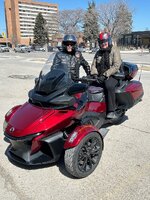That'll probably be because you aren't moving your weight around sufficiently in order to counteract the forces that prompt the Nanny intervention (if your behind is remaining in the one spot on the seat all the time, then that one's a certainty!); maybe it's because you're not being smooth enough in your control input; &/or because you're not picking the right lines to keep it all tidy.

When it comes to picking the right line, if you haven't heard of it already, look up and start practicing 'Late Apexing' (there's one link below) but once you're doing that fairly well most of the time, then just as I was taught and I've since found, both personally and in the majority of those I've helped to come to grips with their Spyders & riding fast but smoothly, that if you use those Nanny interventions as signals (and I still get them, just nowhere near as often as before - but not
yet as infrequently as some of the many better ryders out there!

) to tell you that you've just done something that you could've done better, it usually doesn't take too long to start building your speed, improving your cornering speed and stability, and basically realising the inherent stability and cornering advantages that these Reverse Trikes bring to riding.
As I said earlier "
If you are able to move around on your Spyder enough, take the time to practice, and learn how to move your body weight to enhance the Spyder's unmatched stability and cornering capability while smoothly inputting the necessary control input, you'll find that you can out corner just about anything else at speeds up to about 80 mph, especially in the tight, twisty stuff with short straights.  Ps:
Ps: Lifting a front wheel isn't necessarily an awful thing on a Reverse Trike (but lifting TWO wheels can be!!), just don't touch the brakes while you've got a wheel in the air, and ideally, you would've already moved your weight forward, in, and down toward the inside of the corner. The Nanny will only intervene if you touch your brakes and rapidly slow the wheel in the air, causing it to be rotating at a markedly different speed to the two grounded wheels; &/or if the yaw sensor detects that you are getting close to flipping, but these trikes can raise one wheel seriously high before that happens, and if the raised still wheel keeps spinning at a similar speed to the grounded wheels, you can use your weight transfer
out juuuust a touch to make the lifted wheel stay up there for some 10's of metres without much issue; &/or if you've applied too much steering input too quickly - smooootttthhh ryding rends to avoid that.


